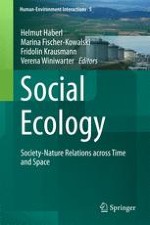2016 | OriginalPaper | Buchkapitel
10. Boundary Issues: Calculating National Material Use for a Globalized World
verfasst von : Anke Schaffartzik, Nina Eisenmenger, Dominik Wiedenhofer
Erschienen in: Social Ecology
Aktivieren Sie unsere intelligente Suche, um passende Fachinhalte oder Patente zu finden.
Wählen Sie Textabschnitte aus um mit Künstlicher Intelligenz passenden Patente zu finden. powered by
Markieren Sie Textabschnitte, um KI-gestützt weitere passende Inhalte zu finden. powered by
